The global truck with mast market is projected to grow from USD 2.2 billion in 2025 to approximately USD 3.3 billion by 2035, recording an absolute increase of USD 1 billion over the forecast period. The truck with mast market is positioned for steady expansion as warehouse operators, logistics providers, and manufacturing facilities continue to prioritize efficient vertical material handling and high-density storage systems. Trucks with mast configurations are essential in distribution centers where palletized goods must be lifted, stacked, and retrieved across multiple height levels. The projected rise from USD 2.2 billion in 2025 to USD 3.3 billion by 2035 is driven by the growth of e-commerce fulfillment centers, increased automation investments, and the ongoing shift toward centralized distribution networks that rely on precise and rapid load handling.
During the forecast period, warehouse designs are increasingly incorporating high-bay racking systems, driving demand for mast trucks capable of reaching elevated lift heights while maintaining stability and control. Cold chain logistics, food processing facilities, and pharmaceutical storage networks are adopting mast-equipped trucks to ensure safe material handling under controlled temperatures and constrained aisle layouts. Manufacturers are focusing on enhanced hydraulic lift mechanisms, improved load stability systems, and operator-assist safety features that support productivity while minimizing operational risk. Additionally, the transition toward electric drive systems, telematics integration, and semi-autonomous fleet management platforms is creating new opportunities for equipment replacement and performance optimization across global logistics ecosystems.

Production capabilities are advancing through specialized hydraulic engineering technologies and automated manufacturing systems that enable consistent quality control while reducing production costs. Leading manufacturers are investing in advanced fabrication equipment and control system development to create truck with mast products that deliver superior lifting performance, extended operational life, and reliable performance under varying load conditions. Material handling equipment suppliers and logistics system specialists are expanding their truck with mast offerings to address specific application requirements across retail distribution, manufacturing logistics, cold chain operations, and general warehousing applications.
Quality standards continue evolving as applications demand higher precision specifications and consistent performance under extreme operating conditions including temperature variations, extended duty cycles, and intensive loading operations. Industry certification programs and testing protocols ensure reliable product performance while supporting market confidence in advanced material handling technology adoption across critical distribution processes and regulated warehouse environments. Compliance requirements for workplace safety and operational efficiency applications are driving investments in comprehensive quality assurance systems and validation procedures throughout the manufacturing supply chain.
International logistics coordination is supporting market development as major distribution projects require standardized material handling solutions across multiple facility locations. Global logistics companies are establishing unified specifications for warehouse equipment that influence worldwide procurement standards and create opportunities for specialized truck with mast manufacturers. Industrial engineering firms are forming partnerships with material handling suppliers to develop application-specific solutions tailored to emerging warehouse automation requirements and distribution facility specifications.
Investment patterns are shifting toward integrated system solutions as distribution facilities seek comprehensive material handling systems that combine vertical capability with advanced operational performance and maintenance-friendly characteristics. Logistics companies are implementing standardized equipment specifications across their facilities, while material handling manufacturers are incorporating advanced truck with mast technology into their warehouse system designs to ensure operational efficiency and safety compliance. This trend toward standardization and performance optimization is reshaping competitive dynamics across the industrial material handling equipment value chain.
Market maturation is evident in the emergence of specialized application segments that demand unique operational characteristics and performance specifications. Cold chain logistics applications require temperature-resistant hydraulic systems and specialized control features under strict environmental requirements, while high-rise warehousing systems need equipment that maintains performance during extended vertical operations and provides consistent lifting precision in automated storage environments. These specialized requirements are driving innovation in hydraulic engineering, control technologies, and integration methodologies that extend beyond traditional material handling applications.
| Metric | Value |
|---|---|
| Market Value (2025) | USD 2.2 billion |
| Market Forecast Value (2035) | USD 3.3 billion |
| Forecast CAGR (2025-2035) | 4.2% |
| WAREHOUSE AUTOMATION EXPANSION | E-COMMERCE INFRASTRUCTURE GROWTH | LOGISTICS EFFICIENCY OPTIMIZATION |
|---|---|---|
| Vertical Storage Systems - Distribution facilities implementing advanced vertical storage capabilities requiring specialized truck with mast equipment for high-bay warehouse operations, automated storage systems, and material handling applications with enhanced lifting performance for distribution center efficiency and space optimization requirements. | Distribution Network Development - E-commerce expansion driving construction of fulfillment centers and distribution facilities requiring comprehensive material handling solutions for order processing, inventory management, and shipping operations with certified performance and operational efficiency documentation. | Operational Cost Reduction - Logistics facility improvements implementing truck with mast technology for productivity enhancement, reduced labor requirements, and improved throughput capabilities while maintaining safe working environments and quality standards. |
| Automation Technology Integration - Material handling equipment advancement requiring integrated truck with mast components for automated warehouse systems, robotic fulfillment operations, and facility automation applications with superior precision control and reliability characteristics. | Facility Modernization Programs - Distribution center standards requiring comprehensive material handling solutions for warehouse operations, equipment installations, and facility upgrades with documented performance and certification requirements. | Equipment Standardization - Logistics system optimization requiring specialized truck with mast components for material handling equipment, process automation, and facility infrastructure with enhanced performance and standardized specifications. |
| System Integration Requirements - Material handling suppliers implementing comprehensive truck with mast solutions for warehouse automation projects, distribution facility installations, and equipment upgrades with specialized design characteristics and performance specifications. | Operational Safety Standards - Workplace safety standards and material handling regulations requiring certified lifting performance for distribution facilities, equipment operations, and worker protection with comprehensive compliance documentation and testing validation. | Maintenance Optimization - Distribution facility cost reduction initiatives requiring durable truck with mast solutions for material handling systems, equipment maintenance optimization, and operational efficiency with proven performance and reliability characteristics. |
| Category | Segments / Values |
|---|---|
| By Type | Electric Walk-Behind Type; Electric Stand-On Type; Internal Combustion Engine Type; Manual Push/Pull Type; Others |
| By Application | High-Rise Warehousing; Cold Chain Logistics; Port Operations; Manufacturing Facilities; Retail Distribution; Others |
| By End-User | Logistics Companies; Manufacturing Companies; Retail Distributors; Port Authorities; Third-Party Logistics Providers; Others |
| By Load Capacity | Light Duty (0-2 Tons); Medium Duty (2-5 Tons); Heavy Duty (5-10 Tons); Extra Heavy Duty (10+ Tons); Others |
| By Lift Height | Low Lift (0-3 Meters); Medium Lift (3-6 Meters); High Lift (6-12 Meters); Extra High Lift (12+ Meters); Others |
| By Region | North America; Europe; Asia Pacific; Latin America; Middle East & Africa |

| Segment | 2025-2035 Outlook |
|---|---|
| Electric Walk-Behind Type | Leader in 2025 with 48.3% market share; preferred choice for warehouse operations and distribution facilities requiring operator efficiency and precise maneuvering capabilities in confined spaces. Widely adopted across logistics facilities and automated warehouse systems. Momentum: strong growth across e-commerce fulfillment and cold storage applications. Watchouts: battery technology limitations and charging infrastructure requirements in high-intensity operations. |
| Electric Stand-On Type | Growing segment with 31.7% share, favored for high-productivity warehouse environments and extended operational cycles requiring operator comfort and enhanced visibility for material handling tasks. Momentum: exceptional growth in large-scale distribution centers and automated storage systems. Watchouts: higher capital investment compared to walk-behind alternatives in cost-sensitive applications. |
| Internal Combustion Engine Type | Traditional segment serving outdoor operations and heavy-duty applications requiring extended runtime without charging infrastructure dependencies. Momentum: steady growth in port operations and industrial manufacturing applications. Watchouts: environmental regulations and emissions requirements limiting adoption in enclosed facilities. |
| Others | Includes manual push/pull types and hybrid systems for specialized application requirements and budget-conscious material handling operations. Momentum: selective growth in small-scale operations and developing market segments. |
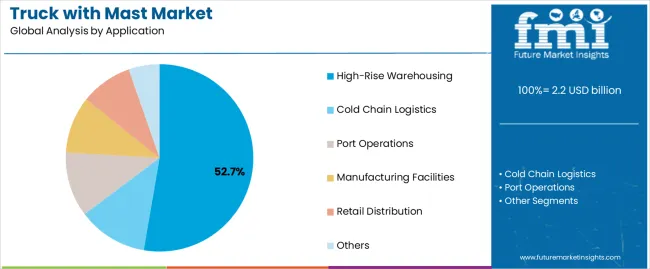
| Segment | 2025-2035 Outlook |
|---|---|
| High-Rise Warehousing | Largest application segment in 2025 at 52.7% share, driven by vertical storage optimization and automated warehouse development requiring advanced lifting capabilities for high-bay storage systems, inventory management, and space utilization efficiency. Momentum: robust growth from warehouse automation advancement and e-commerce infrastructure expansion. Watchouts: technical complexity and operator training requirements for high-altitude operations. |
| Cold Chain Logistics | Critical segment representing 28.4% share, experiencing strong growth from food distribution expansion and pharmaceutical logistics requiring specialized temperature-controlled material handling for refrigerated storage and frozen goods distribution. Momentum: consistent growth as cold storage facilities expand and food safety regulations strengthen workplace requirements. Watchouts: equipment durability challenges and maintenance complexity in extreme temperature environments. |
| Port Operations | Growing segment at 12.6% share for container handling, cargo operations, and maritime logistics requiring heavy-duty material handling solutions for port terminals and shipping facilities. Momentum: moderate growth from international trade expansion and port infrastructure development. Watchouts: harsh operating conditions and corrosive environments affecting equipment longevity. |
| Others | Includes manufacturing facilities, retail distribution, and emerging industrial applications. Momentum: diverse growth opportunities across multiple industrial sectors and specialized material handling requirements. |
| End-User | Status & Outlook (2025-2035) |
|---|---|
| Logistics Companies | Dominant end-user in 2025 with 64.1% share for distribution center operations and warehouse material handling requirements. Provides operational efficiency, throughput optimization, and cost reduction improvements for logistics operations. Momentum: steady growth driven by e-commerce expansion and supply chain modernization investment. Watchouts: competitive pressure and service level requirements across multiple facility locations. |
| Manufacturing Companies | Industrial end-user serving production facility applications and integrated material handling systems requiring certified lifting performance and reliability specifications for manufacturing operations. Momentum: moderate growth as manufacturing facilities enhance material handling capabilities and automation integration. Watchouts: diverse application requirements and customization needs in specialized manufacturing environments. |
| Retail Distributors | Commercial end-user for distribution center applications and inventory management requirements serving retail supply chain operations and store replenishment systems. Momentum: consistent growth as retail distribution networks expand and modernize existing warehouse facilities. Watchouts: seasonal demand variations and inventory management complexity for diverse product categories. |
| Others | Includes port authorities, third-party logistics providers, and emerging commercial end-user categories. Momentum: selective growth opportunities in specialized applications and developing logistics market segments. |
| KEY TRENDS | DRIVERS | RESTRAINTS |
|---|---|---|
| Automation Integration -- Advanced warehouse automation systems and robotic material handling integration enabling comprehensive facility optimization, predictive maintenance capabilities, and operational efficiency enhancement for modern distribution centers with improved productivity characteristics and reduced labor dependencies. | E-Commerce Growth across retail sectors and online distribution networks creating substantial demand for material handling solutions supporting automated fulfillment centers, rapid order processing, and inventory management systems requiring effective vertical storage and operational efficiency compliance. | High Capital Investment in advanced material handling equipment and infrastructure costs limiting adoption of premium truck with mast solutions across budget-constrained distribution facilities and competitive logistics applications with restricted capital equipment budgets. |
| Electric Technology Advancement -- Battery technology improvements and charging infrastructure development delivering enhanced operational runtime, reduced maintenance requirements, and environmental compliance for demanding warehouse applications with improved performance characteristics and extended service intervals. | Warehouse Space Optimization -- Distribution facility efficiency requirements driving adoption of vertical storage technology for warehouse operations, inventory management, and facility utilization applications requiring documented space utilization performance and operational validation. | Skilled Operator Requirements -- Technical complexity and safety training requirements affecting deployment timelines and operational capabilities for distribution facilities lacking specialized material handling expertise and comprehensive operator development programs. |
| IoT Connectivity Integration -- Integration with warehouse management systems, fleet monitoring platforms, and predictive maintenance technologies enabling comprehensive equipment tracking, performance optimization, and automated maintenance scheduling capabilities for enhanced operational reliability. | Supply Chain Modernization -- Logistics infrastructure upgrades and distribution facility enhancements requiring specialized material handling components for improved operational efficiency, reduced handling costs, and enhanced facility productivity with superior performance characteristics. | Regulatory Compliance Complexity -- Diverse safety regulations, environmental standards, and operational requirements creating complexity for suppliers developing standardized material handling solutions across multiple jurisdictions and international logistics markets. |
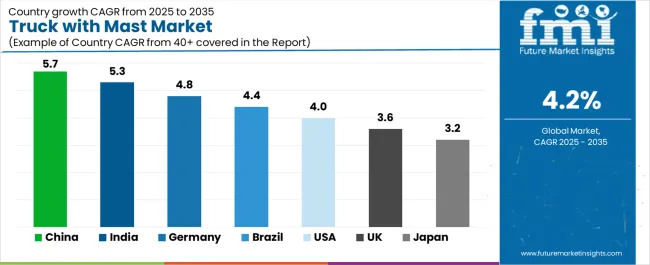
| Country | CAGR (2025-2035) |
|---|---|
| China | 5.7% |
| India | 5.3% |
| Germany | 4.8% |
| Brazil | 4.4% |
| United States | 4% |
| United Kingdom | 3.6% |
| Japan | 3.2% |
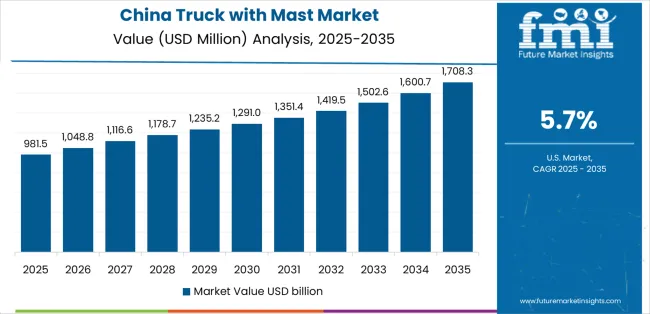
Revenue from truck with mast equipment in China is projected to exhibit strong growth with a market value of USD 1.2 billion by 2035, driven by extensive warehouse automation programs and comprehensive logistics infrastructure development creating substantial opportunities for material handling suppliers across distribution facility construction, e-commerce fulfillment center expansion, and industrial facility development sectors. The country's ambitious logistics modernization programs including national supply chain optimization initiatives and automated distribution facility expansion are creating consistent demand for specialized truck with mast systems. Major logistics companies and material handling equipment suppliers including China National Machinery, Zoomlion, and specialized warehouse equipment manufacturers are establishing comprehensive material handling solution programs to support large-scale distribution operations and advanced logistics technology applications.
Revenue from truck with mast equipment in India is expanding to reach USD 418.3 million by 2035, supported by extensive logistics industry development programs and comprehensive distribution infrastructure modernization initiatives creating demand for material handling solutions across diverse warehouse facility and distribution center application segments. The country's growing e-commerce capabilities and expanding logistics infrastructure are driving demand for truck with mast components that provide exceptional reliability while supporting advanced distribution system requirements. Logistics companies and warehouse facilities are investing in material handling technology to support growing consumer demand and distribution network advancement requirements.
Demand for truck with mast equipment in Germany is projected to reach USD 502.6 million by 2035, supported by the country's leadership in industrial automation technology and advanced logistics systems requiring sophisticated material handling solutions for precision warehouse operations and industrial distribution applications. German logistics operators are implementing cutting-edge material handling platforms that support advanced operational capabilities, precision performance, and comprehensive quality monitoring protocols. The market is characterized by focus on engineering excellence, technology innovation, and compliance with stringent industrial safety and performance standards.
Revenue from truck with mast equipment in Brazil is growing to reach USD 310.7 million by 2035, driven by logistics infrastructure development programs and increasing distribution capabilities creating opportunities for material handling suppliers serving both logistics operators and specialized warehouse contractors. The country's expanding e-commerce sector and growing distribution infrastructure are creating demand for truck with mast components that support diverse warehousing requirements while maintaining performance standards. Logistics companies and distribution facilities are developing technology strategies to support operational efficiency and system reliability advancement.
Demand for truck with mast equipment in United States is projected to reach USD 573.1 million by 2035, expanding at a CAGR of 4%, driven by advanced logistics technology innovation and specialized warehouse applications supporting precision distribution operations and comprehensive automation technology applications. The country's established logistics technology tradition including major distribution companies and fulfillment facilities are creating demand for high-performance truck with mast components that support operational advancement and safety standards. Manufacturers and logistics system suppliers are maintaining comprehensive development capabilities to support diverse distribution and automation requirements.
Revenue from truck with mast equipment in United Kingdom is growing to reach USD 388.9 million by 2035, supported by logistics technology heritage and established distribution engineering communities driving demand for premium material handling solutions across traditional warehouse systems and specialized distribution automation applications. The country's rich industrial logistics heritage including major distribution companies and established warehouse system capabilities create demand for truck with mast components that support both legacy system advancement and modern distribution applications.

Demand for truck with mast equipment in Japan is projected to reach USD 297.4 million by 2035, driven by precision logistics technology tradition and established industrial leadership supporting both domestic warehouse system markets and export-oriented component production. Japanese companies maintain sophisticated truck with mast development capabilities, with established manufacturers continuing to lead in material handling technology and industrial equipment standards.
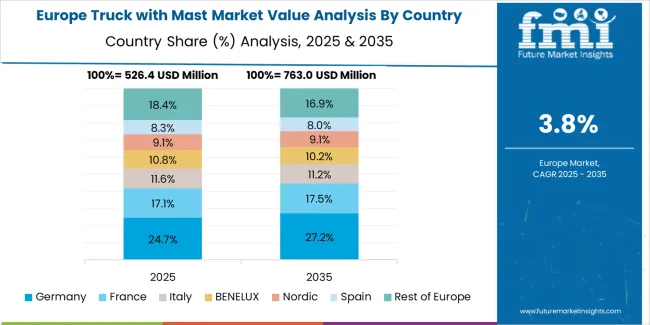
European truck with mast operations are increasingly concentrated between German engineering excellence and specialized manufacturing across multiple countries. German facilities dominate high-performance material handling production for precision warehouse operations and industrial distribution applications, leveraging cutting-edge manufacturing technologies and strict quality protocols that command price premiums in global markets. British logistics technology operators maintain leadership in warehouse system innovation and material handling method development, with organizations like specialized engineering companies and university research centers driving technical specifications that suppliers must meet to access major distribution contracts.
Eastern European operations in Czech Republic and Poland are capturing specialized production contracts through precision manufacturing expertise and EU compliance standards, particularly in component fabrication and assembly technologies for warehouse applications. These facilities increasingly serve as development partners for Western European distribution programs while building their own logistics technology expertise.
The regulatory environment presents both opportunities and constraints. European workplace safety framework requirements create quality standards that favor established European manufacturers and warehouse system operators while ensuring consistent performance specifications for critical distribution infrastructure and safety applications. Brexit has created complexity for UK logistics collaboration with EU programs, driving opportunities for direct relationships between British operators and international truck with mast suppliers.
Technology collaboration accelerates as distribution companies seek technology advancement to support major warehouse modernization milestones and automation development timelines. Vertical integration increases, with major logistics system operators acquiring specialized manufacturing capabilities to secure component supplies and quality control for critical distribution programs. Smaller warehouse contractors face pressure to specialize in niche applications or risk displacement by larger, more comprehensive operations serving mainstream distribution and automation requirements.
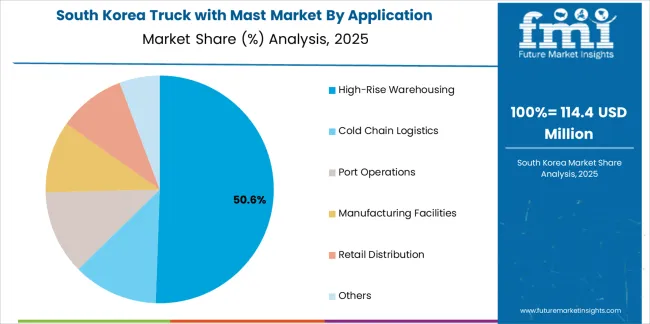
South Korean truck with mast operations reflect the country's advanced logistics technology capabilities and export-oriented industrial development model. Major distribution system operators including major logistics companies and technology firms drive component procurement strategies for their warehouse facilities, establishing direct relationships with specialized truck with mast suppliers to secure consistent quality and performance for their distribution development programs and advanced logistics technology systems targeting both domestic infrastructure and international collaboration projects.
The Korean market demonstrates particular strength in integrating truck with mast technologies into automated warehouse platforms and advanced distribution system configurations, with engineering teams developing solutions that bridge traditional material handling applications and next-generation logistics systems. This integration approach creates demand for specific performance specifications that differ from conventional applications, requiring suppliers to adapt material handling capabilities and system coordination characteristics.
Regulatory frameworks emphasize workplace safety and warehouse system reliability, with Korean industrial standards often exceeding international requirements for truck with mast systems. This creates barriers for standard component suppliers but benefits established manufacturers who can demonstrate industrial-grade performance capabilities. The regulatory environment particularly favors suppliers with Korean warehouse system qualification and comprehensive testing documentation systems.
Supply chain excellence remains critical given Korea's logistics focus and international collaboration dynamics. Distribution system operators increasingly pursue development partnerships with suppliers in Japan, Germany, and specialized manufacturers to ensure access to cutting-edge truck with mast technologies while managing infrastructure risks. Investment in logistics infrastructure supports performance advancement during extended distribution development cycles.

Toyota Material Handling leads the market with 19.2% share owing to its comprehensive material handling equipment portfolio and established logistics industry relationships, which distribution operators use to implement integrated truck with mast solutions across diverse warehouse applications. Profit pools are consolidating upstream in advanced hydraulic system development and downstream in application-specific solutions for warehouse automation, distribution facility integration, and specialized logistics markets where performance reliability, operational efficiency, and consistent lifting precision command substantial premiums. Value is migrating from basic material handling equipment production to specification-driven, application-ready warehouse systems where hydraulic expertise, precision manufacturing, and reliable integration capabilities create competitive advantages.
Several archetypes define market leadership: established Japanese equipment companies defending share through comprehensive material handling system development and proven logistics automation support; German industrial suppliers leveraging manufacturing excellence and engineering capabilities; American technology leaders with warehouse automation expertise and precision logistics heritage; and emerging Asian manufacturers pursuing cost-effective production while developing advanced hydraulic capabilities.
Switching costs - system integration, facility compatibility validation, operational certification - provide stability for established suppliers, while technological advancement requirements and specialized application growth create opportunities for innovative equipment manufacturers. Consolidation continues as companies seek manufacturing scale; direct logistics partnerships grow for specialized applications while traditional material handling distribution remains relationship-driven. Focus areas: secure premium warehouse automation and distribution facility market positions with application-specific performance specifications and technical collaboration; develop truck with mast technology and advanced manufacturing capabilities; explore specialized applications including cold chain logistics and port operation requirements.
| Stakeholder Type | Primary Advantage | Repeatable Plays |
|---|---|---|
| Japanese Equipment Leaders | Comprehensive material handling expertise; proven logistics integration; established operator relationships | Precision manufacturing; technical innovation; operational certification support |
| German Industrial Suppliers | Manufacturing excellence; comprehensive automation development programs; established customer partnerships | Engineering collaboration focus; integrated solutions; technical consultation |
| American Technology Leaders | Warehouse automation expertise; precision technology leadership; trusted by major logistics programs | Distribution partnerships; application-specific specifications; automation infrastructure collaboration |
| Emerging Asian Producers | Manufacturing efficiency; competitive pricing; rapid technology development | Production scaling; technology advancement; market entry strategies |
| Logistics Distributors | Technical distribution networks; warehouse service relationships | Industrial expertise; inventory management; technical support services |
| Item | Value |
|---|---|
| Quantitative Units | USD 2.2 billion |
| Type Segments | Electric Walk-Behind Type; Electric Stand-On Type; Internal Combustion Engine Type; Manual Push/Pull Type; Others |
| Applications | High-Rise Warehousing; Cold Chain Logistics; Port Operations; Manufacturing Facilities; Retail Distribution; Others |
| End-Users | Logistics Companies; Manufacturing Companies; Retail Distributors; Port Authorities; Third-Party Logistics Providers; Others |
| Load Capacity Segments | Light Duty (0-2 Tons); Medium Duty (2-5 Tons); Heavy Duty (5-10 Tons); Extra Heavy Duty (10+ Tons); Others |
| Lift Height Ranges | Low Lift (0-3 Meters); Medium Lift (3-6 Meters); High Lift (6-12 Meters); Extra High Lift (12+ Meters); Others |
| Regions Covered | North America; Latin America; Europe; Asia Pacific; Middle East & Africa |
| Key Countries | China; India; Germany; Brazil; United States; United Kingdom; Japan (+35 additional countries) |
| Key Companies Profiled | Toyota Material Handling; Jungheinrich; Mitsubishi Logisnext; KION Group; Anhui Heli; Hyster-Yale; Hangcha Group; Crown Equipment; Clark Material Handling; Komatsu; EP Equipment; Doosan Industrial Vehicle; Caterpillar; Manitou; Combilift; Linde Material Handling; Still; Nissan Forklift |
| Additional Attributes | Dollar sales by type and application; Regional demand trends (NA, EU, APAC); Competitive landscape; Warehouse vs. industrial adoption patterns; Logistics automation and material handling system integration; Advanced hydraulic innovations driving performance enhancement, operational reliability, and workplace safety excellence |
The global truck with mast market is estimated to be valued at USD 2.2 billion in 2025.
The market size for the truck with mast market is projected to reach USD 3.3 billion by 2035.
The truck with mast market is expected to grow at a 4.2% CAGR between 2025 and 2035.
The key product types in truck with mast market are electric walk-behind type, electric stand-on type, internal combustion engine type, manual push/pull type and others.
In terms of application, high-rise warehousing segment to command 52.7% share in the truck with mast market in 2025.






Full Research Suite comprises of:
Market outlook & trends analysis
Interviews & case studies
Strategic recommendations
Vendor profiles & capabilities analysis
5-year forecasts
8 regions and 60+ country-level data splits
Market segment data splits
12 months of continuous data updates
DELIVERED AS:
PDF EXCEL ONLINE
Truck Mounted Cranes Market Size and Share Forecast Outlook 2025 to 2035
Trucks Market Size and Share Forecast Outlook 2025 to 2035
Truck Loader Crane Market Size and Share Forecast Outlook 2025 to 2035
Truck Market Analysis - Size, Share, and Forecast Outlook 2025 to 2035
Truck Racks Market Size and Share Forecast Outlook 2025 to 2035
Truck Bedliners Market Outlook- Trends & Forecast 2025 to 2035
Truck Mounted Knuckle Boom Cranes Market – Growth & Demand 2025 to 2035
Truck Platooning Market
Truck Mounted Concrete Mixer Market
Semi-Truck Market Size and Share Forecast Outlook 2025 to 2035
Hand Trucks And Dollies Market Size and Share Forecast Outlook 2025 to 2035
Food Truck Market Analysis - Size, Share, and Forecast Outlook 2025 to 2035
Dump Trucks Market Size and Share Forecast Outlook 2025 to 2035
Fire Truck Market Growth - Trends & Forecast 2025 to 2035
Heavy-Truck Composite Component Market Size and Share Forecast Outlook 2025 to 2035
Crane Trucks Market Size and Share Forecast Outlook 2025 to 2035
Mining Trucks Market Size and Share Forecast Outlook 2025 to 2035
Tanker Truck Market Size and Share Forecast Outlook 2025 to 2035
Bucket Trucks Market Analysis - Size, Share, and Forecast Outlook 2025 to 2035
Vacuum Truck Market Size and Share Forecast Outlook 2025 to 2035

Thank you!
You will receive an email from our Business Development Manager. Please be sure to check your SPAM/JUNK folder too.
Chat With
MaRIA